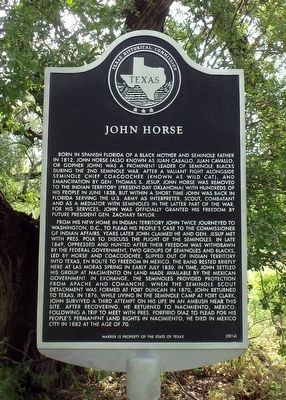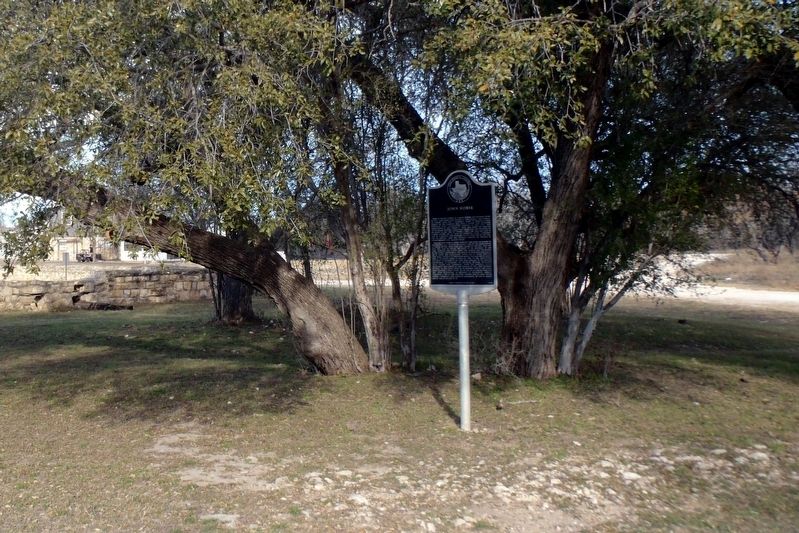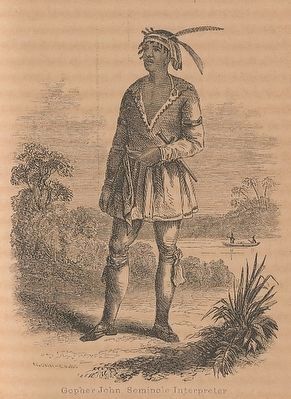Near Brackettville in Kinney County, Texas — The American South (West South Central)
John Horse
Born in Spanish Florida of a black mother and Seminole father in 1812, John Horse (also known as Juan Caballo, Juan Cavallo, or Gopher John) was a prominent leader of Seminole blacks during the 2nd Seminole War. After a valiant fight alongside Seminole chief Coacooche (known as Wild Cat), and emancipation by Gen. Thomas S. Jesup, John Horse was removed to the Indian Territory (present-day Oklahoma) with hundreds of his people in June 1838, but within a short time John was back in Florida serving the U.S. Army as interpreter, scout, combatant and as a mediator with Seminoles in the latter part of the war. For his services, John was officially granted his freedom by future President Gen. Zachary Taylor.
From his new home in Indian Territory John twice journeyed to Washington, D.C. to plead his people’s case to the Commissioner of Indian Affairs. Years later John claimed he and Gen. Jesup met with Pres. Polk to discuss the plight of the Seminole. In late 1849, oppressed and hunted after their freedom was withdrawn by the federal government, two groups of Seminoles and blacks, led by Horse and Coacooche, slipped out of Indian Territory into Texas, enroute to freedom in Mexico. The band rested briefly here at Las Moras spring in early July 1850. In time, John settled his group at Nacimiento on land made available by the Mexican government. In exchange, the Seminoles provided protection from Apache and Comanche. When the Seminole Scout Detachment was formed at Fort Duncan in 1870, John returned to Texas. In 1876, while living in the Seminole camp at Fort Clark, John survived a third attempt on his life in an ambush near this site. After recovering, he returned to Nacimiento, Mexico. Following a trip to meet with Pres. Porfirio Diaz to plead for his people’s permanent land rights in Nacimiento, he died in Mexico City in 1882 at the age of 70.
Erected 2014 by Texas Historical Commission. (Marker Number 18148.)
Topics and series. This historical marker is listed in these topic lists: African Americans • Native Americans • Patriots & Patriotism • Wars, US Indian. In addition, it is included in the Former U.S. Presidents: #12 Zachary Taylor series list. A significant historical year for this entry is 1812.
Location. 29° 17.994′ N, 100° 25.155′ W. Marker is near Brackettville, Texas, in Kinney County. Marker is at the intersection of Travis Road and Cam Hacinda, on the left when traveling east on Travis Road. The marker is located on Fort Clark Springs and is accessible to the public. The marker is in the grove of oak trees just beyond the end of the cemetery wall. Touch for map. Marker is in this post office area: Brackettville TX 78832, United States of America. Touch for directions.
Other nearby markers.
At least 8 other markers are within walking distance of this marker. Site of Original Post Cemetery (within shouting distance of this marker); 1873 Infantry Barracks (approx. 0.3 miles away); Palisado Building Kitchen / Mess Room (approx. 0.3 miles away); Fort Clark Guardhouse (approx. 0.4 miles away); Fort Clark Post Theater (approx. 0.4 miles away); Commanding Officer's Quarters (approx. 0.4 miles away); New Cavalry Barracks (approx. 0.4 miles away); Juan A. Avila 1921-2008 (approx. 0.4 miles away). Touch for a list and map of all markers in Brackettville.
Regarding John Horse. When the Seminole camp near Fort Duncan was abandoned, John moved to the Scout camp on Las Moras Creek at Fort Clark where he settled into the well earned role of revered and wise patriarch. Now in his late sixties, John passed his time frequenting the soldier saloons in Brackettville where he may have enjoyed a semi-celebrity status. Late on Friday afternoon May 19, 1876, John, on his white horse American, was returning from one of his visits to a Brackettville saloon to the Seminole Camp with former scout Titus Payne on foot alongside him. The two passed the post hospital and turned east towards Las Moras Creek and John’s home. As they came parallel with the stone wall of the post cemetery a volley of shots was fired at them from ambush. Titus Payne fell
dead. John was shot four times and his horse wounded in the neck. Severely wounded, John slumped in his saddle but managed to escape. The attack took place within earshot of the post garrison but there is no Army record of the incident. It was known a small segment of the civilian population of Brackettville held very ill-feelings towards the Seminoles. No one was ever held responsible for the murder of Titus Payne or the attempted murder of John Horse.
Credits. This page was last revised on May 17, 2023. It was originally submitted on May 29, 2016, by William F Haenn of Fort Clark (Brackettville), Texas. This page has been viewed 1,423 times since then and 76 times this year. Last updated on November 26, 2021, by William F Haenn of Fort Clark (Brackettville), Texas. Photos: 1. submitted on May 29, 2016, by William F Haenn of Fort Clark (Brackettville), Texas. 2. submitted on May 17, 2023, by William F Haenn of Fort Clark (Brackettville), Texas. 3. submitted on May 29, 2016, by William F Haenn of Fort Clark (Brackettville), Texas. • J. Makali Bruton was the editor who published this page.


